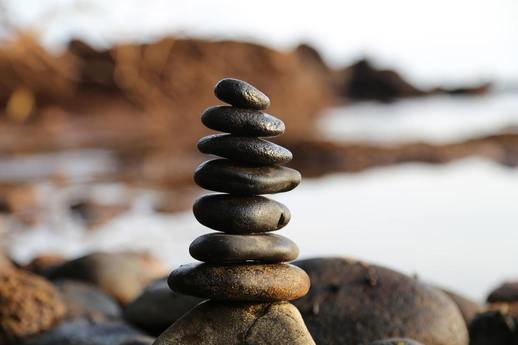|
Have you ever had one of those moments when it feels like the rest of the world doesn’t exist?
When your sight, smell, taste, and touch feels elevated and it’s almost as if you’re seeing everything for the first time? Some people describe this happening when they are with a loved one or looking out to a beautiful view while on vacation and completely at ease. If you’ve ever experienced a peaceful contentment in this way, then you have had what others refer to as a moment of mindfulness. When people go to yoga classes, practice meditation, or use their breath as a tool, they are often attempting to achieve the reprieve that comes with a moment like this. Another way to describe mindfulness would be the intentional focus on the present moment, using curiosity and acceptance of your body and mind’s current experience. It can be a brief moment, a pause in your day. It can be a breath, a statement said to yourself when you are alone in the car, a day spent gardening and riding your bike while noticing all of the colors and textures in the world, a yoga class with intentional breathing, or even 10 minutes with your loved one at the end of the day spent holding their hand and cherishing their presence. What do these moments even give us, and why has mindfulness been such a buzz word? Does an increase in immune function, focus, job satisfaction, ability to regulate emotions, and a reduction of stress sound appealing to anyone? Oh, you too? Mindfulness practice can increase gray matter in the posterior cingulate (mind-wandering), left hippocampus (learning and memory), temporo parietal junction (perspective taking, empathy, and compassion), and pons (communication between the brain stem and cortex, sleep). In other words, it changes the brain in the areas that are important for emotional regulation, focus, and empathy (Holzel, 2011). The amazing thing is that you don’t have to make a radical life change to begin feeling the effects. If you have sixty seconds to spare in your day, you can use mindfulness. Here are some things that I teach my clients to integrate into their lives: Use curiosity and let go of judgment. If the goal of mindfulness is to fully experience the present moment, we can’t do that if we don’t allow ourselves a break from the worries of tomorrow. Judgment keeps our focus on the past and future. Example: “I’m not doing this right. I’ve never been good at sitting still.” Then comes the spiral of thinking about all the moments in your life you haven’t felt good enough and all the moments in the future you are convinced you won’t be able to navigate. Whereas curiosity is the antidote: “What is my body experiencing right now?” There’s no judgment in this, only simple answers rooted in the present moment. Other questions of curiosity might be: “How is my body feeling right now?”, “Where is my attention right now and how can I bring it back to the present?”, “What is my breath doing?”, “What sensations do I feel in my body right now?” Take the role of scientist with your project being to study your current experience, and ask questions that a researcher would if they wanted to capture your present experience as accurately as they could. Take a Self-Compassion Break. Compassion for ourselves helps us let go of the aforementioned judgement that brings stress, anxiety, fear, and a lack of presence within ourselves. Give yourself a moment of forgiveness for something that happened in your day you may be holding on to. Cut yourself a break. Tell yourself that you are sorry you are experiencing something difficult and that it is going to be okay. Tell yourself that this feeling of discomfort will pass. If using curiosity and self-compassion seem difficult, you are not alone. I help my clients practice these things over the course of months, because behind self-judgement are harmful patterns we have used over the course of a lifetime. It takes a lot of practice, and if you aren’t quite there yet, maybe try telling yourself this (or at least hear it from me): “You are in a place of learning and self-discovery. You are using courage, strength, and bravery today by exploring something new. Thank you for doing this. Self-compassion didn’t work for me today, and that is okay. I am not alone in this being a difficult thing to practice. Let’s try something different instead.” And then see below for tools that take just a moment to do, and don’t (typically) involve breaking down generation old patterns: Five Sense Awareness Look around the room and name to yourself what you see, hear, feel, smell, and taste. I like to start this exercise by taking a large, audible breath. Challenge yourself to finding 5 things you see, 4 things you hear, 3 things you feel, 2 things you smell, and 1 thing you taste. Mindful Breathing Notice the pattern of your breath and how your body moves with each exhale and inhale. If you want, change your breath by deepening it and exhaling loudly, counting your breaths, or making your exhales longer than your inhales. Notice any changes to your physical sensation as you do this. Music Listen to a song you find pleasing with your eyes closed and count the number of times you hear a particular word. Bonus points for breathing deeply while doing this. Eating Take your time with what you are eating and notice the flavors, texture, and aroma. Try to slow your breathing and fully chew before swallowing. These seem simple, but I promise they get the job done. Slowing your life down enough to notice the world around you brings positive physiological changes and your emotional experience is sure to follow. Remember that it can take practice, and you may have to experiment a little to find mindfulness tools that best suit you. But that’s okay, because we’re scientists, remember? If you’re interested in practicing mindfulness with me or learning the art of self-compassion, give me an email at [email protected].
1 Comment
|
AuthorEmily Wagner, trauma expert and mental health counselor provides education for anyone looking to improve their mental health. Archives
January 2020
Categories |
Telephone970.878.8281
|
|


 RSS Feed
RSS Feed